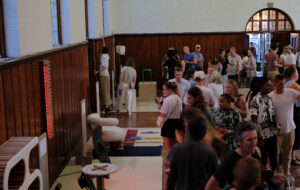|
Design Miami co-founder Craig Robins has transformed a one-time derelict edge-land into a chic shopping district, but the area’s connection to its surroundings remain weak, says Edwin Heathcote The art world is donning its shades and turning its eyes towards Miami at the moment. Parties are being planned, restaurants block-booked, the graffiti in Wynwood is being refreshed. Miami is a place we are familiar with in our minds: palm trees, parties, high-performance sports cars, the beach, art deco hotels, linen suits, Scarface. But actually, it is a bit of a mess. It’s an impossible city to navigate, to walk around, to understand. Instead it is a series of distinct places, each radically different to the other: the beachfront Deco district, the Mediterranean bungalows, the high-rise of Mid-Town, the laid-back MiMo chic of the Lincoln Road Mall. And then there’s the Design District: a one-time semi-derelict edge-land of furniture warehouses and down-market retailers has been transformed by developer and Design Miami co-founder Craig Robins into a chic shopping destination. More than that, Robins has commissioned cool designers to make this into something the city hasn’t seen for a long time – since the Lincoln Road arguably: a walkable, enjoyable piece of real urban fabric. The latest installation is a layered, blue-glass arcade designed by Sou Fujimoto: a delicate, twinkling bauble that seems to bring a bit of Miami’s sky down onto the city streets. In front of it is a reconstruction of Buckminster Fuller’s Fly’s Eye Dome, conceived as a kind of mad Jetsons house (it would levitate if the temperature inside rose too high, admitting cooling breezes beneath it). It is now the exit to the parking garage. There’s a fashionably-faceted condo block going up, designed by Jeanne Gang, as well as a restrained brick storefront by K/R, the “R” of which is Terence Riley, former curator of architecture at MoMA, whose gorgeous Mies-inspired house is just around the corner. There Aranda Lasch’s deco inflected shiny pleated storefront. There will be a big picture by John Baldessari and a wonderfully overblown parking garage with facades by Jürgen Mayer H, Nicolas Buffe and others. Self-consciously supercool. Robins has created a phenomenon. He began by starting up the Deco district and moved onto here where, in barely a decade, he has established a credible urban quarter and a desirable place to be. He has chosen good architects and he has been omnivorous in his taste. You could even argue he’s responsible in large part for the current rash of starchitecture in the city, from Herzog & De Meuron’s Perez Art Museum to the explosion of towers now under construction – by Foster, Hadid, BIG and so on. But there’s still a way to go. Artsy industrial district Wynwood is right next door, yet somehow the two districts don’t seem to connect. This might be a walkable quarter but, so far, there aren’t many places to walk here from. And there’s that niggling doubt about luxury retail. The Design District is now competing with the chi-chi shops of Bal Harbour. Robins is, naturally, delighted – the global brands all want to be here. But the balance between design and designer is delicate. A couple more rhinestones and a handful of diamante could just tip it. |
Words Edwin Heathcote |
|
|
















